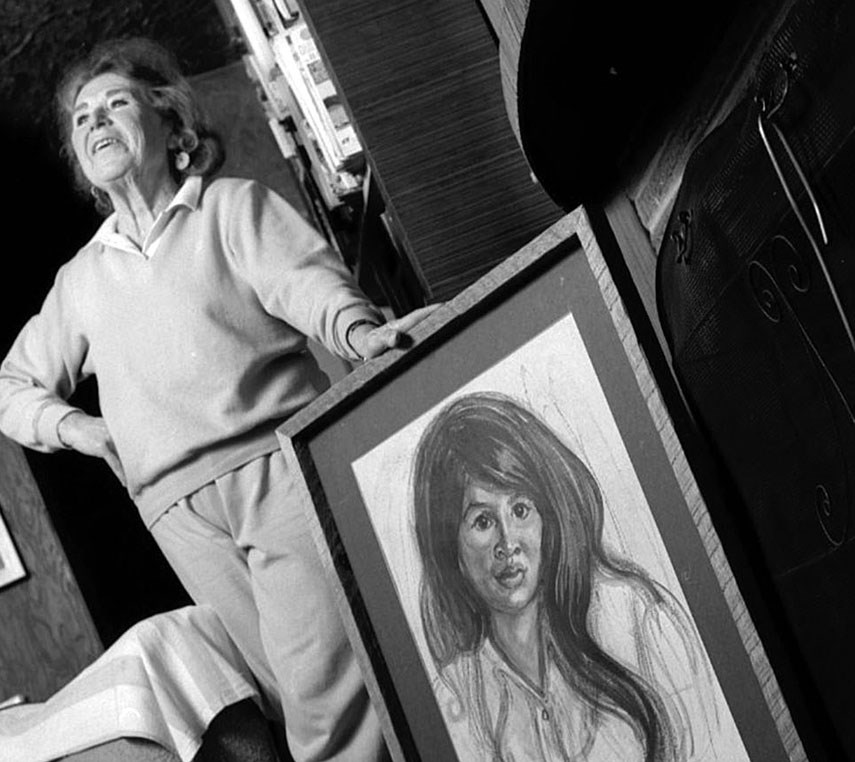Unity Bainbridge couldn’t wait to get out of San Francisco and return to B.C.
An artist of her talent and prestige might have relished the cosmopolitan Californian city, but not Bainbridge. Her artistic allegiance remained firmly rooted in British Columbia her entire life, despite her brief five-year sojourn to San Francisco after getting married in 1946.
“She really missed the West Coast,” explains Bainbridge’s daughter, Deborah Ryan, about her mother’s reverence for B.C.’s landscape, places and people. “You can look around at any of her paintings here – everything was done from life, always.”
Bainbridge passed away peacefully Nov. 30. She was 101 years old.
A longtime resident of West Vancouver, Bainbridge is described as a pioneer B.C. artist who received her formal education at the former Vancouver School of Art.
Despite being widely recognized for her artistic contributions, she always retained an air of anonymity due largely to her intense passion for painting above all else.
“She never was commercial,” Ryan insists. “She wasn’t into the business of art. She was into painting.”
Bainbridge was a contemporary of renowned painters like Emily Carr and the Group of Seven’s Lawren Harris. She was best known as an outstanding painter or sketcher of the province’s unique landscapes, people and its overall heritage.
Her mantra was simple: “Never paint from anything but real life, whether it is a person or a flower,” Bainbridge is known to have said – and words she lived by, too.
Rejecting the artist’s conceit of painting from a studio using only the inner workings of the mind, Bainbridge preferred to let nature itself become her place of work.
“I remember when I was a kid she’d take me and plunk me on a log or whatever and then she’d be gone,” she’d walk up to someone who looked interesting and ask to paint them, Ryan says.
She often journeyed to remote areas of the province, such as Lillooet and the Seton Portage areas, in order to paint portraits of people and places. She loved to paint heritage buildings, old churches, farm houses, and nature. She had a special relationship with B.C. First Nations members, especially the Squamish Nation, many of whom she befriended and painted throughout the years.
“She really believed fervently that people should not paint from a photograph – that you have to paint from the soul of your subject, whether it’s a flower, a person, a tree, or a landscape. It has a soul, and photographs don’t have souls,” Ryan explains.
Bainbridge was born in Victoria, B.C. in 1916. Ryan says her mother knew from a young age that capturing B.C. history through art would be her lifelong calling, and despite her resistance to having her work marketed, her paintings can be found in the collections of the Vancouver Art Gallery, Buckingham Palace, London’s Imperial War Museum, the Diefenbaker Museum, and other galleries across Canada.
She was awarded the Order of British Columbia in 1993. Ryan estimates that her mother produced upwards of 2,500 pieces during her lifetime.
But she could be a contemptuous critic of how her art was received, Ryan says.
“She would only sell her originals to people she approved of,” she says. “She wanted people to have a connection with her paintings. It was not an investment. It was something you would love and care about.”
A recent two-week exhibition at West Vancouver’s Ferry Building Gallery helped demonstrate the degree to which the community still cares for her work.
The exhibition, called Beauty is All There Is: Unity Bainbridge - A Retrospective, was a highlight for West Vancouver District community arts supervisor and Ferry Building curator Juliana Bedoya.
“It was really one of the most moving events I have put together as a curator because what happened was everyday people from the community would come and feel so connected to the artwork and to her as a woman and as an artist,” Bedoya says.
Bainbridge was able to visit the exhibition and carefully moved through the space, observing her past paintings with fond memories, Bedoya says.
One specific painting was particularly moving. A piece called Squamish Mother and Child, painted in 1965, featured a woman and her baby who was the daughter in law of Chief Joe Mathias of the Squamish Nation.
The baby in the photo, now 52-year-old Dulcie Mathias, made an appearance at the exhibition, along with 30 other Squamish Nation members dressed in full regalia.
They came to pay homage to Bainbridge and her years of friendship and exemplary work.
“She was actually establishing relationships – and meaningful ones,” Bedoya says about her body of work.
Weeks later, a mere 12 days before Bainbridge’s passing, Squamish Nation members again visited her, this time at Inglewood Care Centre.
In ceremonial fashion, the nation members presented her with a blanket and sang songs of a spiritual dimension.
“They sang the songs to help her spirit move forward,” Ryan describes, adding that her mother only started to slow down in the last three years of her life but her sharp artistic mind remained in action.
She also talks about several illustrated books of poetry that Bainbridge put out decades ago based on her pilgrimages throughout B.C. Asked why Bainbridge felt the need to write as well as paint, Ryan says it was because she was an artist, above all else.
“An artist paints, dances, sings writes. I think her work dances. If you look at any of her work there’s dancing in it, there’s life. And she had to express herself in many ways,” she says.



